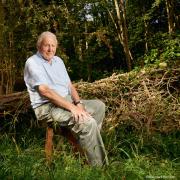The first biography to focus exclusively on Sir Philip Sassoon has been written by Kent politician Damian Collins, who is the MP for Folkestone and Hythe, as was Sassoon from 1912 until his death in 1939.
Both men read Modern History at Oxford and became involved in the creative world – Damian’s career before politics was with M&C Saatchi and he is a co-founder of the Conservative Arts and Creative Industries Network and has served as a parliamentary private secretary in the coalition government.
Sassoon was a hugely influential figure in both the art world and the politics of his day; as a host, he connected the great politicians, artists and thinkers at the height of British global power and influence.
Both men share a love of Port Lympne, one of the stunning homes Sassoon had built especially built for him, now a luxury hotel owned by the Aspinall Foundation – where the most recent developments at the Port Lympne Reserve include the launch of the Dinosaur Forest and a Tiger Lodge, which is due to open in July.
It was visiting Port Lympne with his wife and young children (who love the tigers) that inspired Damian to write Charmed Life - The Phenomenal World of Philip Sassoon, which also happens to be his first book.
“I realised I knew very little about Sir Philip Sassoon, but the more I looked into his life, the more fascinated I became,” the MP told me.
“I think because he died just three months before the Second World War started, he became part of the that lost golden era; war had closed a chapter on that.”
A fabulously wealthy member of the Jewish Sassoon family and a cousin of Siegfried Sassoon, Philip was a glamorous and pivotal figure in this period.
During the First World War he worked at the right hand of General Haig, then with Lloyd George for the settlement of the peace.
He was close to King Edward VIII during the abdication crisis and Minister for the Air Force in the 1930s. He also attained prominence in the art world and high society and had a reputation for being one of the greatest hosts in Britain.
At his famous parties, at Trent Park and particularly Port Lympne, you might find Winston Churchill arguing over the tea cups with George Bernard Shaw, the Prince of Wales playing tennis with Charlie Chaplin, Noël Coward mingling with flamingos and Lawrence of Arabia and Rex Whistler painting murals as the party carried on.
Sassoon’s world is seen as an inspiration for Evelyn Waugh’s Brideshead Revisited; indeed his estate at Trent Park is even referenced in the novel by the character Anthony Blanche.
Philip’s sister Sybil recalled that Philip “loved Lympne very much because he had built it himself.” Sir Herbert Baker had designed and built the mansion before the war, but as he was unavailable to finish the project, Philip brought in fashionable young architect Philip Tilden to complete the interior and external works.
The two were kindred spirits – dynamic and creative, of similar age and shared artistic tastes. Although on the outside Port Lympne looked just like an old English manor, they wanted everything inside the mansion to be new, modern, forceful, and commissioned exclusively from contemporary artists. It was at this ‘lovely and luxurious’ place at his legendary parties that he connected the great politicians, artists and thinkers of the day at the height of British global power.
The heir of a family of wealthy Jewish traders from the souks of Baghdad, he craved acceptance from the English establishment, many of whom thought him both foreign and too exotic. He opened his house to his friends but rarely his heart; he was almost certainly homosexual.
“Today we would refer to him as a networker and connector,” added Damian. “Born in Paris and educated in England, nevertheless he was always seen as never wholly ‘English’. He was compared to Aladdin or the King of Persia from The Arabian Nights, but he was quite the modern figure and very, very unorthodox.”
In Charmed, Damian Collins explores an extraordinary product of an age; a man who, before dying prematurely, aged 50, in June 1939, Noël Coward called a ‘phenomenon that would never recur’. w



























